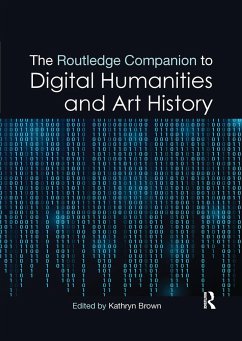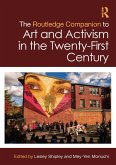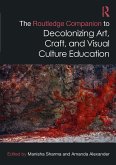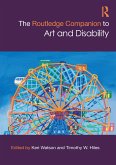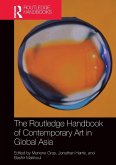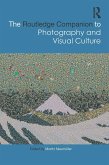The Routledge Companion to Digital Humanities and Art History
Herausgeber: Brown, Kathryn
The Routledge Companion to Digital Humanities and Art History
Herausgeber: Brown, Kathryn
- Broschiertes Buch
- Merkliste
- Auf die Merkliste
- Bewerten Bewerten
- Teilen
- Produkt teilen
- Produkterinnerung
- Produkterinnerung
The Routledge Companion to Digital Humanities and Art History offers a broad survey of cutting-edge intersections between digital technologies and the study of art history, museum practices, and cultural heritage.
Andere Kunden interessierten sich auch für
![The Routledge Companion to Contemporary Art, Visual Culture, and Climate Change The Routledge Companion to Contemporary Art, Visual Culture, and Climate Change]() The Routledge Companion to Contemporary Art, Visual Culture, and Climate Change62,99 €
The Routledge Companion to Contemporary Art, Visual Culture, and Climate Change62,99 €![The Routledge Companion to Art and Activism in the Twenty-First Century The Routledge Companion to Art and Activism in the Twenty-First Century]() The Routledge Companion to Art and Activism in the Twenty-First Century250,99 €
The Routledge Companion to Art and Activism in the Twenty-First Century250,99 €![The Routledge Companion to Global Photographies The Routledge Companion to Global Photographies]() The Routledge Companion to Global Photographies305,99 €
The Routledge Companion to Global Photographies305,99 €![The Routledge Companion to Decolonizing Art, Craft, and Visual Culture Education The Routledge Companion to Decolonizing Art, Craft, and Visual Culture Education]() The Routledge Companion to Decolonizing Art, Craft, and Visual Culture Education270,99 €
The Routledge Companion to Decolonizing Art, Craft, and Visual Culture Education270,99 €![The Routledge Companion to Art and Disability The Routledge Companion to Art and Disability]() The Routledge Companion to Art and Disability50,99 €
The Routledge Companion to Art and Disability50,99 €![The Routledge Handbook of Contemporary Art in Global Asia The Routledge Handbook of Contemporary Art in Global Asia]() The Routledge Handbook of Contemporary Art in Global Asia70,99 €
The Routledge Handbook of Contemporary Art in Global Asia70,99 €![The Routledge Companion to Photography and Visual Culture The Routledge Companion to Photography and Visual Culture]() The Routledge Companion to Photography and Visual Culture58,99 €
The Routledge Companion to Photography and Visual Culture58,99 €-
-
-
The Routledge Companion to Digital Humanities and Art History offers a broad survey of cutting-edge intersections between digital technologies and the study of art history, museum practices, and cultural heritage.
Hinweis: Dieser Artikel kann nur an eine deutsche Lieferadresse ausgeliefert werden.
Hinweis: Dieser Artikel kann nur an eine deutsche Lieferadresse ausgeliefert werden.
Produktdetails
- Produktdetails
- Routledge Art History and Visual Studies Companions
- Verlag: Taylor & Francis Ltd
- Seitenzahl: 524
- Erscheinungstermin: 13. Juni 2022
- Englisch
- Abmessung: 174mm x 247mm x 33mm
- Gewicht: 912g
- ISBN-13: 9781032336398
- ISBN-10: 1032336390
- Artikelnr.: 67073689
- Herstellerkennzeichnung
- Libri GmbH
- Europaallee 1
- 36244 Bad Hersfeld
- gpsr@libri.de
- Routledge Art History and Visual Studies Companions
- Verlag: Taylor & Francis Ltd
- Seitenzahl: 524
- Erscheinungstermin: 13. Juni 2022
- Englisch
- Abmessung: 174mm x 247mm x 33mm
- Gewicht: 912g
- ISBN-13: 9781032336398
- ISBN-10: 1032336390
- Artikelnr.: 67073689
- Herstellerkennzeichnung
- Libri GmbH
- Europaallee 1
- 36244 Bad Hersfeld
- gpsr@libri.de
Kathryn Brown is a lecturer in art history and visual culture at Loughborough University, UK.
List of Figures; List of Table; List of Contributors; Introduction (
Kathryn Brown); Part I: Histories and Critical Debates; 1 Digital Methods
and the Historiography of Art (Paul B. Jaskot); 2 Blind Spot: Information
Visualization and Art History (Johanna Drucker); 3 The Digital
Transformation of Art History (Harald Klinke); 4 Feminist Digital Art
History (Kathryn Brown and Elspeth Mitchell); 5 Slow Digital Art History
and KUbism: Or, Situation Awareness and the Promise of Open-World Games (
Koenraad Brosens, Bruno Cardoso, and Fred Truyen); Part II: Archives,
Networks, and Maps; 6 Tangled Metaphors: Network Thinking and Network
Analysis in the History of Art (Matthew D. Lincoln); 7 Digital Humanities
for a Spatial, Global, and Social History of Art (Béatrice Joyeux-Prunel);
8 Mapping Paintings, or How to Breathe Life Into Provenance (Jodi Cranston
); 9 Qualitative Approaches to Network Analysis in Art History: Research on
Contemporary Artists' Networks (Sanja Sekelj); 10 Mapping Senufo: Mapping
as a Method to Transcend Colonial Assumptions (Susan Elizabeth Gagliardi);
11 X-Reception: Re-mediating Trans- Feminist and Queer Performance Art (
T.L. Cowan); 12 Digital Methods and the Study of the Art Market (Pamela
Fletcher and Anne Helmreich); 13 Noise Management in the Archival
Ecosystem: Debating Principles for Classification (Anna Dot and Pablo Santa
Olalla); Part III: Museums: Real, Virtual, and Augmented; 14 Digital
Imaging Projects for Asian Art and Visual Culture: Transcultural Mediations
and Collaborations (Katherine R. Tsiang); 15 A Field Guide to Digital
Surrogates: Evaluating and Contextualizing a Rapidly Changing Resource (
Emma Stanford); 16 A Service-Orientation and Open-Source Approach to
Developing Virtual Museums (Martin White and Ben Jackson); 17 Art History,
Heritage Games, and Virtual Reality (Erik Champion and Anna Foka); 18 Art
With a Lifespan: Digital Technologies and the Preservation of BioArt (
Christl Baur); 19 The Expanding Role of Digitized Collections: The Medici
Archive (Alessio Assonitis); 20 Digital Languages for Art History: Audience
Engagement, Virtual and Augmented Reality (Stefania De Vincentis and Luca
Nicolò Vascon); Part IV: Computational Techniques for Analyzing Artworks;
21 Curation, Content, Creation: Computer Approaches to the Fine Arts (
Javier de la Rosa and Juan-Luis Suárez); 22 Computerized Analysis of
Paintings (James Z. Wang, Baris Kandemir, and Jia Li); 23 Digital 3D
Modeling for the History of Art (Amy Jeffs); 24 Metadata, Material Culture,
and Global Art History (Robert Wellington); 25 Image Processing and
Computer Vision in the Field of Art History (Nuria Rodríguez-Ortega); 26
Pointers and Proxies: Thoughts on the Computational Modeling of the
Phenomenal World (Alison Langmead and David Newbury); 27 Approaching Aby
Warburg and Digital Art History: Thinking Through Images (Amanda Du Preez
); 28 Analyzing Gesture in Digital Art History (Leonardo Impett); 29
Digital Techniques for the Study of Portuguese Azulejos (Glazed Tiles):
Between Alice's White Rabbit and the Mad Tea Party (Rosário Salema de
Carvalho, Rafaela Xavier, and Inês Leitão); Part V: Digital Resources,
Publication, and Education; 30 The Database of Modern Exhibitions (DoME):
European Paintings and Drawings 1905-1915 (Christina Bartosch, Nirmalie
Mulloli, Daniel Burckhardt, Marei Döhring, Walid Ahmad, and Raphael
Rosenberg); 31 The Art-Historical Catalogue in the Digital Era (Anne
Collins Goodyear); 32 Digital Provenance, Open Access, and Data-Driven Art
History (Anne Luther); 33 Research, Process, Publication, and Pedagogy:
Reconstructing the World's Columbian Exposition of 1893 (Lisa M. Snyder);
34 Social Media in the Art History Classroom (Lauren Jimerson and Allison
Leigh); Index
Kathryn Brown); Part I: Histories and Critical Debates; 1 Digital Methods
and the Historiography of Art (Paul B. Jaskot); 2 Blind Spot: Information
Visualization and Art History (Johanna Drucker); 3 The Digital
Transformation of Art History (Harald Klinke); 4 Feminist Digital Art
History (Kathryn Brown and Elspeth Mitchell); 5 Slow Digital Art History
and KUbism: Or, Situation Awareness and the Promise of Open-World Games (
Koenraad Brosens, Bruno Cardoso, and Fred Truyen); Part II: Archives,
Networks, and Maps; 6 Tangled Metaphors: Network Thinking and Network
Analysis in the History of Art (Matthew D. Lincoln); 7 Digital Humanities
for a Spatial, Global, and Social History of Art (Béatrice Joyeux-Prunel);
8 Mapping Paintings, or How to Breathe Life Into Provenance (Jodi Cranston
); 9 Qualitative Approaches to Network Analysis in Art History: Research on
Contemporary Artists' Networks (Sanja Sekelj); 10 Mapping Senufo: Mapping
as a Method to Transcend Colonial Assumptions (Susan Elizabeth Gagliardi);
11 X-Reception: Re-mediating Trans- Feminist and Queer Performance Art (
T.L. Cowan); 12 Digital Methods and the Study of the Art Market (Pamela
Fletcher and Anne Helmreich); 13 Noise Management in the Archival
Ecosystem: Debating Principles for Classification (Anna Dot and Pablo Santa
Olalla); Part III: Museums: Real, Virtual, and Augmented; 14 Digital
Imaging Projects for Asian Art and Visual Culture: Transcultural Mediations
and Collaborations (Katherine R. Tsiang); 15 A Field Guide to Digital
Surrogates: Evaluating and Contextualizing a Rapidly Changing Resource (
Emma Stanford); 16 A Service-Orientation and Open-Source Approach to
Developing Virtual Museums (Martin White and Ben Jackson); 17 Art History,
Heritage Games, and Virtual Reality (Erik Champion and Anna Foka); 18 Art
With a Lifespan: Digital Technologies and the Preservation of BioArt (
Christl Baur); 19 The Expanding Role of Digitized Collections: The Medici
Archive (Alessio Assonitis); 20 Digital Languages for Art History: Audience
Engagement, Virtual and Augmented Reality (Stefania De Vincentis and Luca
Nicolò Vascon); Part IV: Computational Techniques for Analyzing Artworks;
21 Curation, Content, Creation: Computer Approaches to the Fine Arts (
Javier de la Rosa and Juan-Luis Suárez); 22 Computerized Analysis of
Paintings (James Z. Wang, Baris Kandemir, and Jia Li); 23 Digital 3D
Modeling for the History of Art (Amy Jeffs); 24 Metadata, Material Culture,
and Global Art History (Robert Wellington); 25 Image Processing and
Computer Vision in the Field of Art History (Nuria Rodríguez-Ortega); 26
Pointers and Proxies: Thoughts on the Computational Modeling of the
Phenomenal World (Alison Langmead and David Newbury); 27 Approaching Aby
Warburg and Digital Art History: Thinking Through Images (Amanda Du Preez
); 28 Analyzing Gesture in Digital Art History (Leonardo Impett); 29
Digital Techniques for the Study of Portuguese Azulejos (Glazed Tiles):
Between Alice's White Rabbit and the Mad Tea Party (Rosário Salema de
Carvalho, Rafaela Xavier, and Inês Leitão); Part V: Digital Resources,
Publication, and Education; 30 The Database of Modern Exhibitions (DoME):
European Paintings and Drawings 1905-1915 (Christina Bartosch, Nirmalie
Mulloli, Daniel Burckhardt, Marei Döhring, Walid Ahmad, and Raphael
Rosenberg); 31 The Art-Historical Catalogue in the Digital Era (Anne
Collins Goodyear); 32 Digital Provenance, Open Access, and Data-Driven Art
History (Anne Luther); 33 Research, Process, Publication, and Pedagogy:
Reconstructing the World's Columbian Exposition of 1893 (Lisa M. Snyder);
34 Social Media in the Art History Classroom (Lauren Jimerson and Allison
Leigh); Index
List of Figures; List of Table; List of Contributors; Introduction (
Kathryn Brown); Part I: Histories and Critical Debates; 1 Digital Methods
and the Historiography of Art (Paul B. Jaskot); 2 Blind Spot: Information
Visualization and Art History (Johanna Drucker); 3 The Digital
Transformation of Art History (Harald Klinke); 4 Feminist Digital Art
History (Kathryn Brown and Elspeth Mitchell); 5 Slow Digital Art History
and KUbism: Or, Situation Awareness and the Promise of Open-World Games (
Koenraad Brosens, Bruno Cardoso, and Fred Truyen); Part II: Archives,
Networks, and Maps; 6 Tangled Metaphors: Network Thinking and Network
Analysis in the History of Art (Matthew D. Lincoln); 7 Digital Humanities
for a Spatial, Global, and Social History of Art (Béatrice Joyeux-Prunel);
8 Mapping Paintings, or How to Breathe Life Into Provenance (Jodi Cranston
); 9 Qualitative Approaches to Network Analysis in Art History: Research on
Contemporary Artists' Networks (Sanja Sekelj); 10 Mapping Senufo: Mapping
as a Method to Transcend Colonial Assumptions (Susan Elizabeth Gagliardi);
11 X-Reception: Re-mediating Trans- Feminist and Queer Performance Art (
T.L. Cowan); 12 Digital Methods and the Study of the Art Market (Pamela
Fletcher and Anne Helmreich); 13 Noise Management in the Archival
Ecosystem: Debating Principles for Classification (Anna Dot and Pablo Santa
Olalla); Part III: Museums: Real, Virtual, and Augmented; 14 Digital
Imaging Projects for Asian Art and Visual Culture: Transcultural Mediations
and Collaborations (Katherine R. Tsiang); 15 A Field Guide to Digital
Surrogates: Evaluating and Contextualizing a Rapidly Changing Resource (
Emma Stanford); 16 A Service-Orientation and Open-Source Approach to
Developing Virtual Museums (Martin White and Ben Jackson); 17 Art History,
Heritage Games, and Virtual Reality (Erik Champion and Anna Foka); 18 Art
With a Lifespan: Digital Technologies and the Preservation of BioArt (
Christl Baur); 19 The Expanding Role of Digitized Collections: The Medici
Archive (Alessio Assonitis); 20 Digital Languages for Art History: Audience
Engagement, Virtual and Augmented Reality (Stefania De Vincentis and Luca
Nicolò Vascon); Part IV: Computational Techniques for Analyzing Artworks;
21 Curation, Content, Creation: Computer Approaches to the Fine Arts (
Javier de la Rosa and Juan-Luis Suárez); 22 Computerized Analysis of
Paintings (James Z. Wang, Baris Kandemir, and Jia Li); 23 Digital 3D
Modeling for the History of Art (Amy Jeffs); 24 Metadata, Material Culture,
and Global Art History (Robert Wellington); 25 Image Processing and
Computer Vision in the Field of Art History (Nuria Rodríguez-Ortega); 26
Pointers and Proxies: Thoughts on the Computational Modeling of the
Phenomenal World (Alison Langmead and David Newbury); 27 Approaching Aby
Warburg and Digital Art History: Thinking Through Images (Amanda Du Preez
); 28 Analyzing Gesture in Digital Art History (Leonardo Impett); 29
Digital Techniques for the Study of Portuguese Azulejos (Glazed Tiles):
Between Alice's White Rabbit and the Mad Tea Party (Rosário Salema de
Carvalho, Rafaela Xavier, and Inês Leitão); Part V: Digital Resources,
Publication, and Education; 30 The Database of Modern Exhibitions (DoME):
European Paintings and Drawings 1905-1915 (Christina Bartosch, Nirmalie
Mulloli, Daniel Burckhardt, Marei Döhring, Walid Ahmad, and Raphael
Rosenberg); 31 The Art-Historical Catalogue in the Digital Era (Anne
Collins Goodyear); 32 Digital Provenance, Open Access, and Data-Driven Art
History (Anne Luther); 33 Research, Process, Publication, and Pedagogy:
Reconstructing the World's Columbian Exposition of 1893 (Lisa M. Snyder);
34 Social Media in the Art History Classroom (Lauren Jimerson and Allison
Leigh); Index
Kathryn Brown); Part I: Histories and Critical Debates; 1 Digital Methods
and the Historiography of Art (Paul B. Jaskot); 2 Blind Spot: Information
Visualization and Art History (Johanna Drucker); 3 The Digital
Transformation of Art History (Harald Klinke); 4 Feminist Digital Art
History (Kathryn Brown and Elspeth Mitchell); 5 Slow Digital Art History
and KUbism: Or, Situation Awareness and the Promise of Open-World Games (
Koenraad Brosens, Bruno Cardoso, and Fred Truyen); Part II: Archives,
Networks, and Maps; 6 Tangled Metaphors: Network Thinking and Network
Analysis in the History of Art (Matthew D. Lincoln); 7 Digital Humanities
for a Spatial, Global, and Social History of Art (Béatrice Joyeux-Prunel);
8 Mapping Paintings, or How to Breathe Life Into Provenance (Jodi Cranston
); 9 Qualitative Approaches to Network Analysis in Art History: Research on
Contemporary Artists' Networks (Sanja Sekelj); 10 Mapping Senufo: Mapping
as a Method to Transcend Colonial Assumptions (Susan Elizabeth Gagliardi);
11 X-Reception: Re-mediating Trans- Feminist and Queer Performance Art (
T.L. Cowan); 12 Digital Methods and the Study of the Art Market (Pamela
Fletcher and Anne Helmreich); 13 Noise Management in the Archival
Ecosystem: Debating Principles for Classification (Anna Dot and Pablo Santa
Olalla); Part III: Museums: Real, Virtual, and Augmented; 14 Digital
Imaging Projects for Asian Art and Visual Culture: Transcultural Mediations
and Collaborations (Katherine R. Tsiang); 15 A Field Guide to Digital
Surrogates: Evaluating and Contextualizing a Rapidly Changing Resource (
Emma Stanford); 16 A Service-Orientation and Open-Source Approach to
Developing Virtual Museums (Martin White and Ben Jackson); 17 Art History,
Heritage Games, and Virtual Reality (Erik Champion and Anna Foka); 18 Art
With a Lifespan: Digital Technologies and the Preservation of BioArt (
Christl Baur); 19 The Expanding Role of Digitized Collections: The Medici
Archive (Alessio Assonitis); 20 Digital Languages for Art History: Audience
Engagement, Virtual and Augmented Reality (Stefania De Vincentis and Luca
Nicolò Vascon); Part IV: Computational Techniques for Analyzing Artworks;
21 Curation, Content, Creation: Computer Approaches to the Fine Arts (
Javier de la Rosa and Juan-Luis Suárez); 22 Computerized Analysis of
Paintings (James Z. Wang, Baris Kandemir, and Jia Li); 23 Digital 3D
Modeling for the History of Art (Amy Jeffs); 24 Metadata, Material Culture,
and Global Art History (Robert Wellington); 25 Image Processing and
Computer Vision in the Field of Art History (Nuria Rodríguez-Ortega); 26
Pointers and Proxies: Thoughts on the Computational Modeling of the
Phenomenal World (Alison Langmead and David Newbury); 27 Approaching Aby
Warburg and Digital Art History: Thinking Through Images (Amanda Du Preez
); 28 Analyzing Gesture in Digital Art History (Leonardo Impett); 29
Digital Techniques for the Study of Portuguese Azulejos (Glazed Tiles):
Between Alice's White Rabbit and the Mad Tea Party (Rosário Salema de
Carvalho, Rafaela Xavier, and Inês Leitão); Part V: Digital Resources,
Publication, and Education; 30 The Database of Modern Exhibitions (DoME):
European Paintings and Drawings 1905-1915 (Christina Bartosch, Nirmalie
Mulloli, Daniel Burckhardt, Marei Döhring, Walid Ahmad, and Raphael
Rosenberg); 31 The Art-Historical Catalogue in the Digital Era (Anne
Collins Goodyear); 32 Digital Provenance, Open Access, and Data-Driven Art
History (Anne Luther); 33 Research, Process, Publication, and Pedagogy:
Reconstructing the World's Columbian Exposition of 1893 (Lisa M. Snyder);
34 Social Media in the Art History Classroom (Lauren Jimerson and Allison
Leigh); Index

